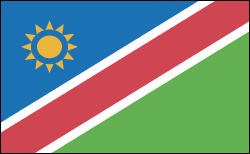Guide to New Nations: Namibia and Eritrea

Africa
by David Johnson |
| Namibia Namibia received its independence on March 21, 1990, from neighboring South Africa, which had administered Namibia after receiving a United Nations mandate to do so in 1920. A republic, Namibia has sought to diversify its economy since achieving independence. However, the country remains heavily dependent on mining exports and agriculture. The world's fifth largest uranium producer, Namibia also contains substantial diamond deposits. |  Namibia Flag |
 | Eritrea Following one of the longest wars in history, which included struggling against the Italian colonialists and later Ethiopia, Eritrea formally declared its independence May 24, 1993. In a referendum held earlier that year, 98% of the Eritrean electorate voted for independence. Eritrean guerrillas had helped victorious Ethiopian rebels overthrow dictator Haile Mariam Mengistu in 1991. In gratitude for Eritrean support, Ethiopia's new president, Meles Zenawi, approved Eritrean independence. The new nation began facing its enormous problems. There were 750,000 war refugees, and some 2.7 million people dependent on outside food aid. The government began improving agricultural production and rebuilding its industrial base. |


